Paper Menu >>
Journal Menu >>
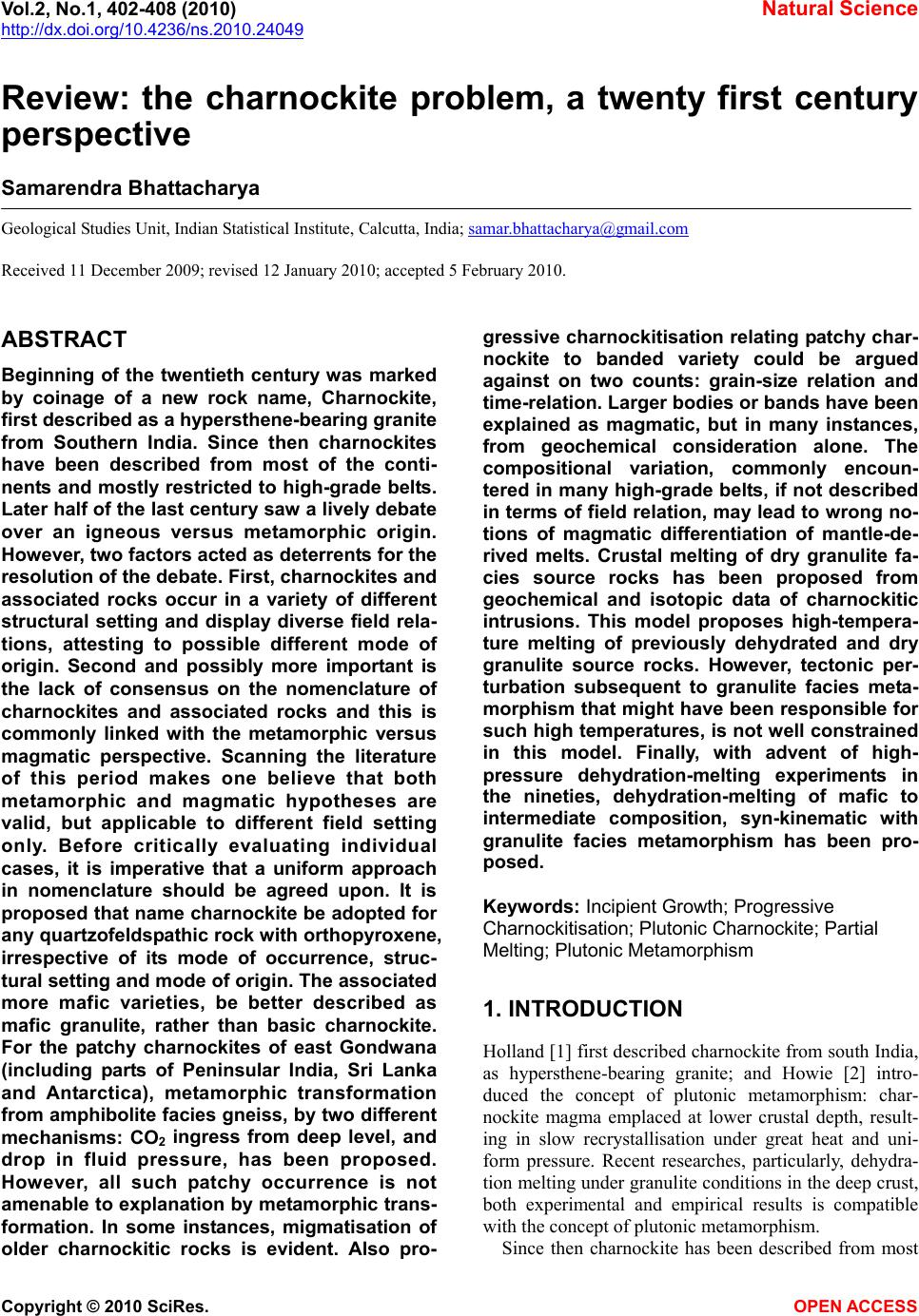 Vol.2, No.1, 402-408 (2010) Natural Science http://dx.doi.org/10.4236/ns.2010.24049 Copyright © 2010 SciRes. OPEN ACCESS Review: the charnockite problem, a twenty first century perspective Samarendra Bhattacharya Geological Studies Unit, Indian Statistical Institute, Calcutta, India; samar.bhattacharya@gmail.com Received 11 December 2009; revised 12 January 2010; accepted 5 February 2010. ABSTRACT Beginning of the twentieth century was marked by coinage of a new rock name, Charnockite, first described as a hypersthene-bearing granite from Southern India. Since then charnockites have been described from most of the conti- nents and mostly restricted to high-grade belts. Later half of the last century saw a lively debate over an igneous versus metamorphic origin. However, two factors acted as deterrents for the resolution of the debate. First, charnockites and associated rocks occur in a variety of different structural setting and display diverse field rela- tions, attesting to possible different mode of origin. Second and possibly more important is the lack of consensus on the nomenclature of charnockites and associated rocks and this is commonly linked with the metamorphic versus magmatic perspective. Scanning the literature of this period makes one believe that both metamorphic and magmatic hypotheses are valid, but applicable to different field setting only. Before critically evaluating individual cases, it is imperative that a uniform approach in nomenclature should be agreed upon. It is proposed that name charnockite be adopted for any quartzofeldspathic rock with orthopyroxene, irrespective of its mode of occurrence, struc- tural setting and mode of origin. The associated more mafic varieties, be better described as mafic granulite, rather than basic charnockite. For the patchy charnockites of east Gondwana (including parts of Peninsular India, Sri Lanka and Antarctica), metamorphic transformation from amphibolite facies gneiss, by two different mechanisms: CO2 ingress from deep level, and drop in fluid pressure, has been proposed. However, all such patchy occurrence is not amenable to explanation by metamorphic trans- formation. In some instances, migmatisation of older charnockitic rocks is evident. Also pro- gressive charnockitisation relating patchy char- nockite to banded variety could be argued against on two counts: grain-size relation and time-relation. Larger bodies or bands have been explained as magmatic, but in many instances, from geochemical consideration alone. The compositional variation, commonly encoun- tered in many high-grade belts, if not described in terms of field relation, may lead to wrong no- tions of magmatic differentiation of mantle-de- rived melts. Crustal melting of dry granulite fa- cies source rocks has been proposed from geochemical and isotopic data of charnockitic intrusions. This model proposes high-tempera- ture melting of previously dehydrated and dry granulite source rocks. However, tectonic per- turbation subsequent to granulite facies meta- morphism that might have been responsible for such high temperatures, is not well constrained in this model. Finally, with advent of high- pressure dehydration-melting experiments in the nineties, dehydration-melting of mafic to intermediate composition, syn-kinematic with granulite facies metamorphism has been pro- posed. Keywords: Incipient Growth; Progressive Charnockitisation; Plutonic Charnockite; Partial Melting; Plutonic Metamorphism 1. INTRODUCTION Holland [1] first described charnockite from south India, as hypersthene-bearing granite; and Howie [2] intro- duced the concept of plutonic metamorphism: char- nockite magma emplaced at lower crustal depth, result- ing in slow recrystallisation under great heat and uni- form pressure. Recent researches, particularly, dehydra- tion melting under granulite conditions in the deep crust, both experimental and empirical results is compatible with the concept of plutonic metamorphism. Since then charnockite has been described from most 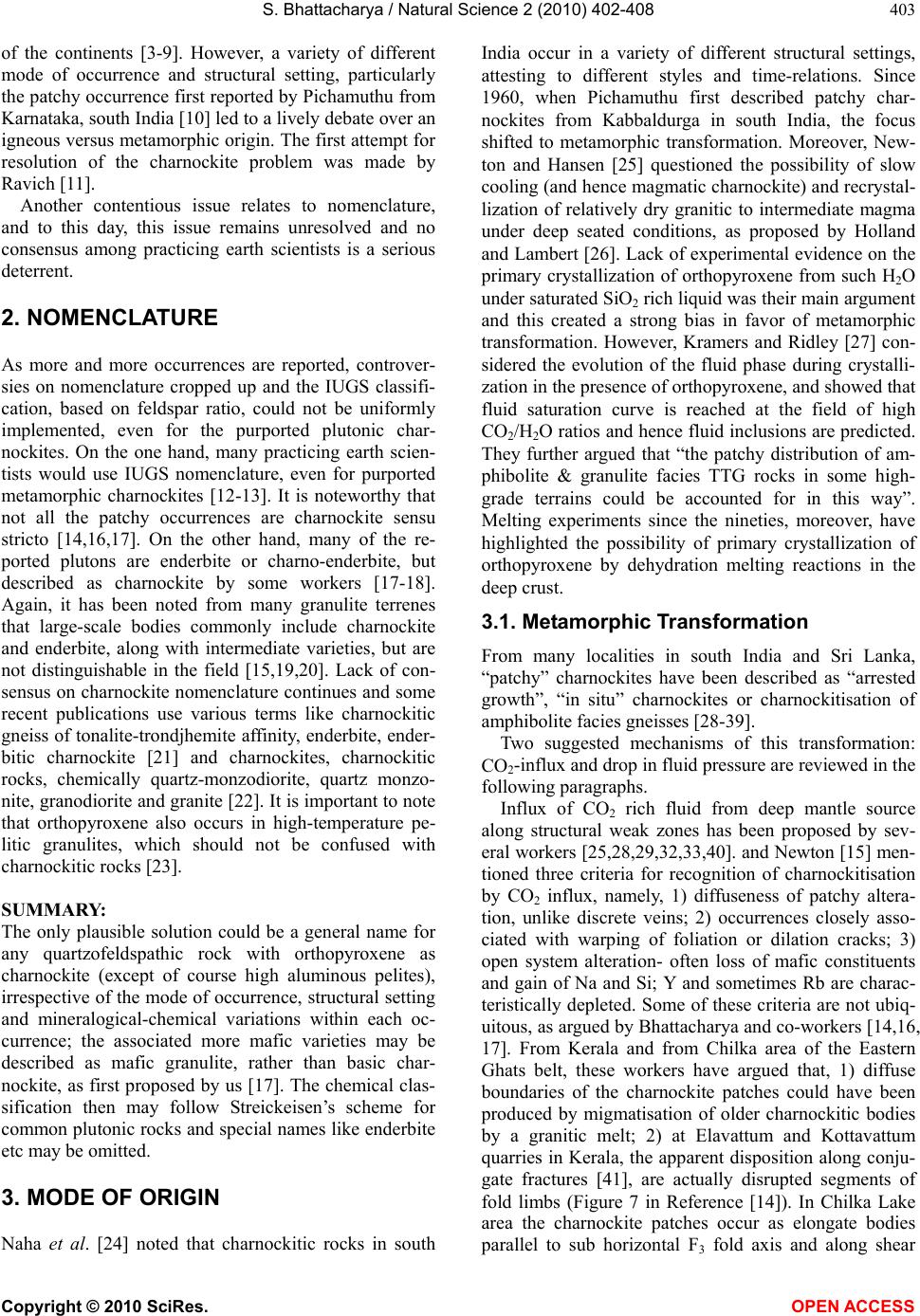 S. Bhattacharya / Natural Science 2 (2010) 402-408 Copyright © 2010 SciRes. OPEN ACCESS 403 of the continents [3-9]. However, a variety of different mode of occurrence and structural setting, particularly the patchy occurrence first reported by Pichamuthu from Karnataka, south India [10] led to a lively debate over an igneous versus metamorphic origin. The first attempt for resolution of the charnockite problem was made by Ravich [11]. Another contentious issue relates to nomenclature, and to this day, this issue remains unresolved and no consensus among practicing earth scientists is a serious deterrent. 2. NOMENCLATURE As more and more occurrences are reported, controver- sies on nomenclature cropped up and the IUGS classifi- cation, based on feldspar ratio, could not be uniformly implemented, even for the purported plutonic char- nockites. On the one hand, many practicing earth scien- tists would use IUGS nomenclature, even for purported metamorphic charnockites [12-13]. It is noteworthy that not all the patchy occurrences are charnockite sensu stricto [14,16,17]. On the other hand, many of the re- ported plutons are enderbite or charno-enderbite, but described as charnockite by some workers [17-18]. Again, it has been noted from many granulite terrenes that large-scale bodies commonly include charnockite and enderbite, along with intermediate varieties, but are not distinguishable in the field [15,19,20]. Lack of con- sensus on charnockite nomenclature continues and some recent publications use various terms like charnockitic gneiss of tonalite-trondjhemite affinity, enderbite, ender- bitic charnockite [21] and charnockites, charnockitic rocks, chemically quartz-monzodiorite, quartz monzo- nite, granodiorite and granite [22]. It is important to note that orthopyroxene also occurs in high-temperature pe- litic granulites, which should not be confused with charnockitic rocks [23]. SUMMARY: The only plausible solution could be a general name for any quartzofeldspathic rock with orthopyroxene as charnockite (except of course high aluminous pelites), irrespective of the mode of occurrence, structural setting and mineralogical-chemical variations within each oc- currence; the associated more mafic varieties may be described as mafic granulite, rather than basic char- nockite, as first proposed by us [17]. The chemical clas- sification then may follow Streickeisen’s scheme for common plutonic rocks and special names like enderbite etc may be omitted. 3. MODE OF ORIGIN Naha et al. [24] noted that charnockitic rocks in south India occur in a variety of different structural settings, attesting to different styles and time-relations. Since 1960, when Pichamuthu first described patchy char- nockites from Kabbaldurga in south India, the focus shifted to metamorphic transformation. Moreover, New- ton and Hansen [25] questioned the possibility of slow cooling (and hence magmatic charnockite) and recrystal- lization of relatively dry granitic to intermediate magma under deep seated conditions, as proposed by Holland and Lambert [26]. Lack of experimental evidence on the primary crystallization of orthopyroxene from such H2O under saturated SiO2 rich liquid was their main argument and this created a strong bias in favor of metamorphic transformation. However, Kramers and Ridley [27] con- sidered the evolution of the fluid phase during crystalli- zation in the presence of orthopyroxene, and showed that fluid saturation curve is reached at the field of high CO2/H2O ratios and hence fluid inclusions are predicted. They further argued that “the patchy distribution of am- phibolite & granulite facies TTG rocks in some high- grade terrains could be accounted for in this way”. Melting experiments since the nineties, moreover, have highlighted the possibility of primary crystallization of orthopyroxene by dehydration melting reactions in the deep crust. 3.1. Metamorphic Transformation From many localities in south India and Sri Lanka, “patchy” charnockites have been described as “arrested growth”, “in situ” charnockites or charnockitisation of amphibolite facies gneisses [28-39]. Two suggested mechanisms of this transformation: CO2-influx and drop in fluid pressure are reviewed in the following paragraphs. Influx of CO2 rich fluid from deep mantle source along structural weak zones has been proposed by sev- eral workers [25,28,29,32,33,40]. and Newton [15] men- tioned three criteria for recognition of charnockitisation by CO2 influx, namely, 1) diffuseness of patchy altera- tion, unlike discrete veins; 2) occurrences closely asso- ciated with warping of foliation or dilation cracks; 3) open system alteration- often loss of mafic constituents and gain of Na and Si; Y and sometimes Rb are charac- teristically depleted. Some of these criteria are not ubiq- uitous, as argued by Bhattacharya and co-workers [14,16, 17]. From Kerala and from Chilka area of the Eastern Ghats belt, these workers have argued that, 1) diffuse boundaries of the charnockite patches could have been produced by migmatisation of older charnockitic bodies by a granitic melt; 2) at Elavattum and Kottavattum quarries in Kerala, the apparent disposition along conju- gate fractures [41], are actually disrupted segments of fold limbs (Figure 7 in Reference [14]). In Chilka Lake area the charnockite patches occur as elongate bodies parallel to sub horizontal F3 fold axis and along shear 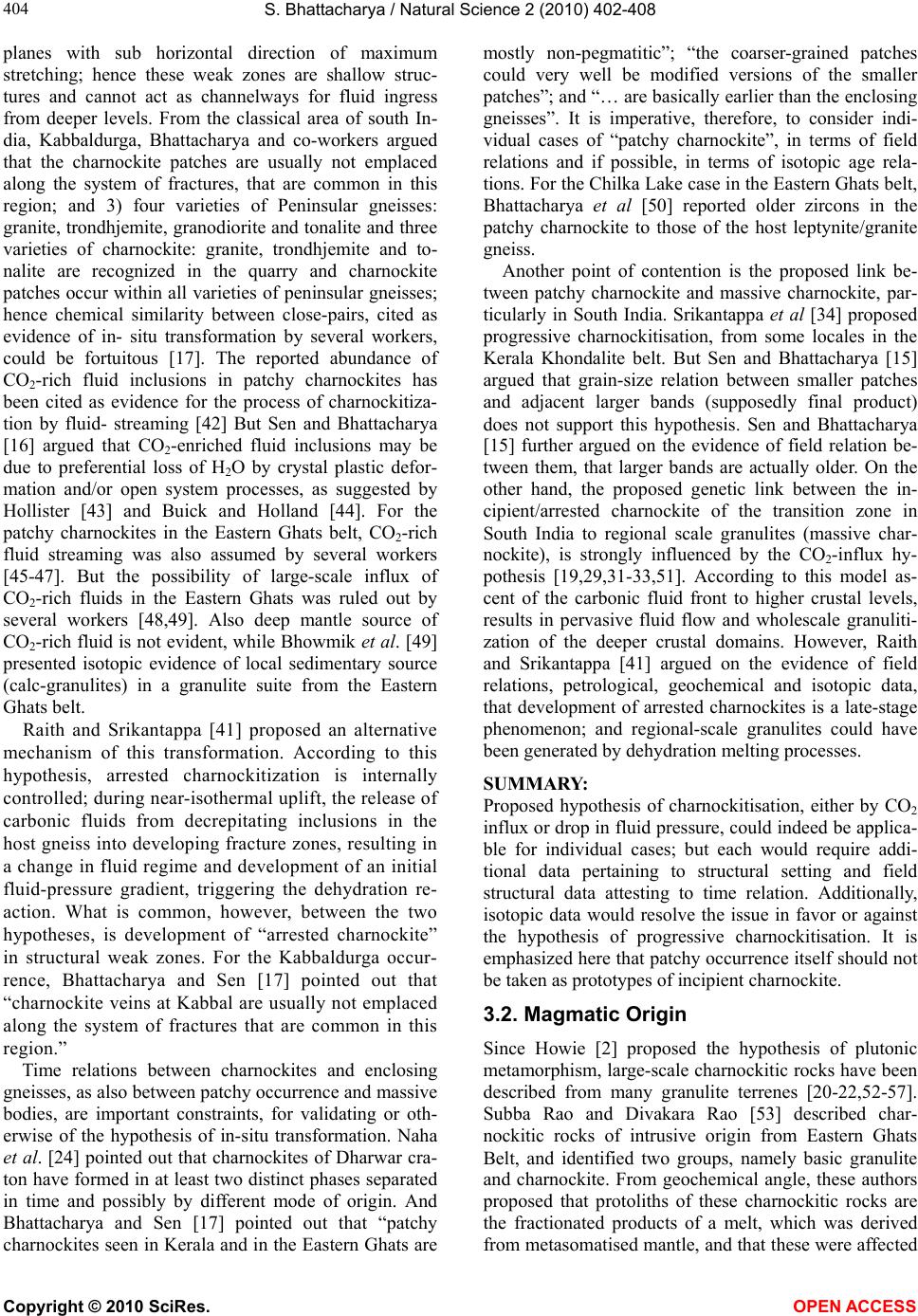 S. Bhattacharya / Natural Science 2 (2010) 402-408 Copyright © 2010 SciRes. OPEN ACCESS 404 planes with sub horizontal direction of maximum stretching; hence these weak zones are shallow struc- tures and cannot act as channelways for fluid ingress from deeper levels. From the classical area of south In- dia, Kabbaldurga, Bhattacharya and co-workers argued that the charnockite patches are usually not emplaced along the system of fractures, that are common in this region; and 3) four varieties of Peninsular gneisses: granite, trondhjemite, granodiorite and tonalite and three varieties of charnockite: granite, trondhjemite and to- nalite are recognized in the quarry and charnockite patches occur within all varieties of peninsular gneisses; hence chemical similarity between close-pairs, cited as evidence of in- situ transformation by several workers, could be fortuitous [17]. The reported abundance of CO2-rich fluid inclusions in patchy charnockites has been cited as evidence for the process of charnockitiza- tion by fluid- streaming [42] But Sen and Bhattacharya [16] argued that CO2-enriched fluid inclusions may be due to preferential loss of H2O by crystal plastic defor- mation and/or open system processes, as suggested by Hollister [43] and Buick and Holland [44]. For the patchy charnockites in the Eastern Ghats belt, CO2-rich fluid streaming was also assumed by several workers [45-47]. But the possibility of large-scale influx of CO2-rich fluids in the Eastern Ghats was ruled out by several workers [48,49]. Also deep mantle source of CO2-rich fluid is not evident, while Bhowmik et al. [49] presented isotopic evidence of local sedimentary source (calc-granulites) in a granulite suite from the Eastern Ghats belt. Raith and Srikantappa [41] proposed an alternative mechanism of this transformation. According to this hypothesis, arrested charnockitization is internally controlled; during near-isothermal uplift, the release of carbonic fluids from decrepitating inclusions in the host gneiss into developing fracture zones, resulting in a change in fluid regime and development of an initial fluid-pressure gradient, triggering the dehydration re- action. What is common, however, between the two hypotheses, is development of “arrested charnockite” in structural weak zones. For the Kabbaldurga occur- rence, Bhattacharya and Sen [17] pointed out that “charnockite veins at Kabbal are usually not emplaced along the system of fractures that are common in this region.” Time relations between charnockites and enclosing gneisses, as also between patchy occurrence and massive bodies, are important constraints, for validating or oth- erwise of the hypothesis of in-situ transformation. Naha et al. [24] pointed out that charnockites of Dharwar cra- ton have formed in at least two distinct phases separated in time and possibly by different mode of origin. And Bhattacharya and Sen [17] pointed out that “patchy charnockites seen in Kerala and in the Eastern Ghats are mostly non-pegmatitic”; “the coarser-grained patches could very well be modified versions of the smaller patches”; and “… are basically earlier than the enclosing gneisses”. It is imperative, therefore, to consider indi- vidual cases of “patchy charnockite”, in terms of field relations and if possible, in terms of isotopic age rela- tions. For the Chilka Lake case in the Eastern Ghats belt, Bhattacharya et al [50] reported older zircons in the patchy charnockite to those of the host leptynite/granite gneiss. Another point of contention is the proposed link be- tween patchy charnockite and massive charnockite, par- ticularly in South India. Srikantappa et al [34] proposed progressive charnockitisation, from some locales in the Kerala Khondalite belt. But Sen and Bhattacharya [15] argued that grain-size relation between smaller patches and adjacent larger bands (supposedly final product) does not support this hypothesis. Sen and Bhattacharya [15] further argued on the evidence of field relation be- tween them, that larger bands are actually older. On the other hand, the proposed genetic link between the in- cipient/arrested charnockite of the transition zone in South India to regional scale granulites (massive char- nockite), is strongly influenced by the CO2-influx hy- pothesis [19,29,31-33,51]. According to this model as- cent of the carbonic fluid front to higher crustal levels, results in pervasive fluid flow and wholescale granuliti- zation of the deeper crustal domains. However, Raith and Srikantappa [41] argued on the evidence of field relations, petrological, geochemical and isotopic data, that development of arrested charnockites is a late-stage phenomenon; and regional-scale granulites could have been generated by dehydration melting processes. SUMMARY: Proposed hypothesis of charnockitisation, either by CO2 influx or drop in fluid pressure, could indeed be applica- ble for individual cases; but each would require addi- tional data pertaining to structural setting and field structural data attesting to time relation. Additionally, isotopic data would resolve the issue in favor or against the hypothesis of progressive charnockitisation. It is emphasized here that patchy occurrence itself should not be taken as prototypes of incipient charnockite. 3.2. Magmatic Origin Since Howie [2] proposed the hypothesis of plutonic metamorphism, large-scale charnockitic rocks have been described from many granulite terrenes [20-22,52-57]. Subba Rao and Divakara Rao [53] described char- nockitic rocks of intrusive origin from Eastern Ghats Belt, and identified two groups, namely basic granulite and charnockite. From geochemical angle, these authors proposed that protoliths of these charnockitic rocks are the fractionated products of a melt, which was derived from metasomatised mantle, and that these were affected  S. Bhattacharya / Natural Science 2 (2010) 402-408 Copyright © 2010 SciRes. OPEN ACCESS 405 by a depletion event probably coeval with granulite fa- cies metamorphism. Although, two groups were said to be identified “based upon field relations and chemistry”, the actual field relation between basic granulite and charnockite is not described in this publication. More- over, as noted earlier by several workers, local structural setting and sample locations are important criteria, and without these information, the applicability of the mantle melting model proposed by these authors can be ques- tioned. In this context, it is important to note that from detailed field mapping and structural analysis in the Chilka Lake area of the Eastern Ghats belt, India, Bhat- tacharya et al [57] argued that “certainly an igneous protolith which has suffered granulite facies metamor- phism (as evidenced by inter-layered basic granulites) is a distinct possibility”. It is unfortunate that some work- ers concluded that in the Eastern Ghats belt, age rela- tions may be deduced from field relations, but neither do they present any data, nor refer to published information; hence their conclusion that “intruding magmas are either mantle-derived (basic granulites, enderbites and char- nockites with crustal contribution)…..” remains ques- tionable [58]. Bhattacharya and co-workers described two types of field relations between charnockitic rocks and metapelitic rocks. First type is the interbanding of the two lithologies; the time relation is uncertain, though both may have undergone granulite facies metamor- phism together [57,59]. The other type of field relation between the two lithologies is all the more complex; large-scale bodies of charnockitic rocks usually occur as separate exposures, and no contact between the two could be observed; no pelitic enclaves were observed in charnockites. Only on the basis of the sequence of de- formation structure, a tentative correlation has been proposed: mafic granulite, occurring as folded enclaves in charnockite, could be correlated to intrafolial folds in pelitic granulites [57,60]. Dobmeier and Raith [13] also observed that “since the enderbitic and metasedimentary rocks have identical structural histories, the emplace- ment (of enderbitic/tonalitic magma) happened prior to the discernible deformation…” in the Chilka Lake area. Magmatic origin of charnockite is also proposed by several workers in the nineties. Kilpatrick and Ellis [7] described Charnockite Magma Type, or C-type, from different areas, with distinctive geochemical signatures. This C-type magma was considered to be derived by melting of a dry granulite source. It should be noted that this C-type magma is not strictly charnockite sensu stricto, but varies between charno-enderbite and char- nockite (see K2O/Na2O ratios and SiO2 values in Table 1 of Reference [7]). Also the melting here is considered to have been post-granulite facies metamorphism and a crustal-melting event. Melting of dry granulite-facies source rocks, for Antarctican charnockites, was also proposed by some workers from geochemical and iso- topic data [20,55,61]. On the other hand, Sheraton et al. [54] argued that more mafic varieties may be largely mantle-derived. It is important to note that these reports on Antarctican charnockites show a range of composi- tion from quartz monzodiorite through granodiorite to adamelite. Hence, discrimination between charnockite and enderbite magma, in massif-type or intrusive char- nockite, was considered inappropriate by these authors. This model proposes high-temperature melting of pre- viously dehydrated and dry granulite source rocks. But tectonic perturbation subsequent to granulite facies meta- morphism that might have been responsible for such high-temperatures is not well constrained in this model. A partial melting interpretation for vein type char- nockite was advocated by Hansen and Stuk [62], and these authors reported orthopyroxene-bearing leu- cosomes, of tonalitic to granodioritic composition, within mafic bodies of granulite facies rocks from Cali- fornia. Finally, melting experiments, particularly dehydra- tion-melting experiments of mafic to intermediate rocks in the nineties have added a new dimension to the prob- lem of charnockite genesis [63-66]. These experiments demonstrate a) significant melting at 8 to 10 kbar and temperatures in excess of 850oC; these values are com- monly recorded from many granulite terrains; b) the re- sidual assemblage of two-pyroxene-plagioclase-quartz ± garnet, clearly resemble mafic granulite, that are fre- quently found associated with massif-type charnockite; c) melt compositions in hornblende-dehydration melting range from tonalite-granodiorite-trondjhemite, while hornblende-biotite combined melting produced granitic melts. From the classic area, Kabbaldurga, in South India, Bhattacharya and Sen [17] presented a new interpreta- tion of vein type charnockite. These authors proposed hornblende and biotite dehydration melting in two types of mafic granulites observed in the area, producing two types of charnockitic vein, of tonalitic and granitic compositions respectively. Besides the field features, such as orthopyroxene-bearing leucosomes within mafic granulite enclaves in the peninsular gneiss; these authors presented comparative mineral compositions in the charnockite veins and mafic granulite enclaves and bulk compositions of the charnockite veins, and these are compatible with the results of experimental melting, referred to above. For the massif-type charnockite in the Eastern Ghats belt, India, Kar et al. [56] proposed a hornblende- dehy- dration melting in mafic rocks, now occurring as cognate xenoliths, under granulite facies conditions. Additionally these authors reported two types of mafic granulites, namely prograde hornblende-bearing mafic granulite, interpreted as restitic granulite and two-pyroxene mafic granulite, interpreted as peritectic segregations. 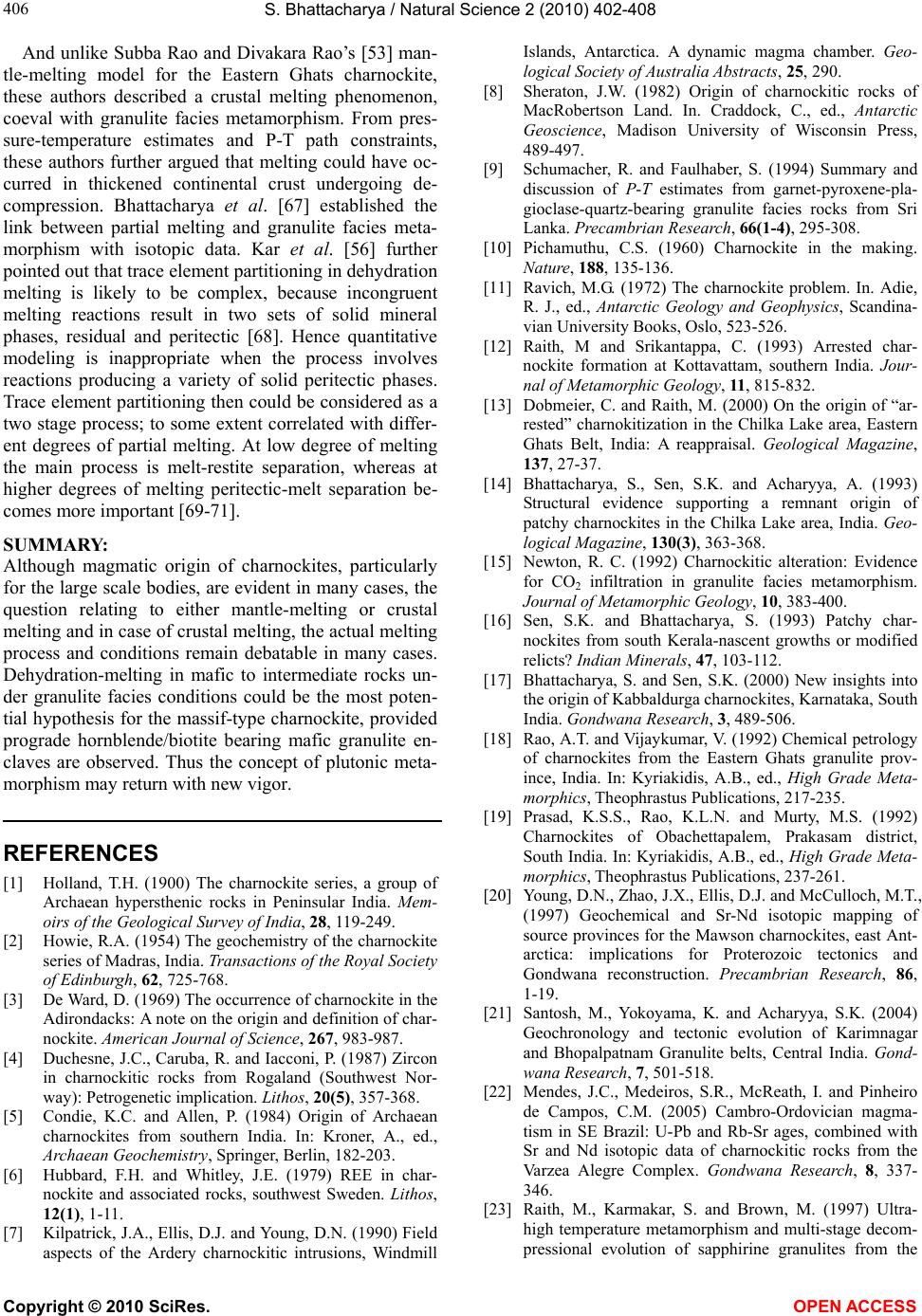 S. Bhattacharya / Natural Science 2 (2010) 402-408 Copyright © 2010 SciRes. OPEN ACCESS 406 And unlike Subba Rao and Divakara Rao’s [53] man- tle-melting model for the Eastern Ghats charnockite, these authors described a crustal melting phenomenon, coeval with granulite facies metamorphism. From pres- sure-temperature estimates and P-T path constraints, these authors further argued that melting could have oc- curred in thickened continental crust undergoing de- compression. Bhattacharya et al. [67] established the link between partial melting and granulite facies meta- morphism with isotopic data. Kar et al. [56] further pointed out that trace element partitioning in dehydration melting is likely to be complex, because incongruent melting reactions result in two sets of solid mineral phases, residual and peritectic [68]. Hence quantitative modeling is inappropriate when the process involves reactions producing a variety of solid peritectic phases. Trace element partitioning then could be considered as a two stage process; to some extent correlated with differ- ent degrees of partial melting. At low degree of melting the main process is melt-restite separation, whereas at higher degrees of melting peritectic-melt separation be- comes more important [69-71]. SUMMARY: Although magmatic origin of charnockites, particularly for the large scale bodies, are evident in many cases, the question relating to either mantle-melting or crustal melting and in case of crustal melting, the actual melting process and conditions remain debatable in many cases. Dehydration-melting in mafic to intermediate rocks un- der granulite facies conditions could be the most poten- tial hypothesis for the massif-type charnockite, provided prograde hornblende/biotite bearing mafic granulite en- claves are observed. Thus the concept of plutonic meta- morphism may return with new vigor. REFERENCES [1] Holland, T.H. (1900) The charnockite series, a group of Archaean hypersthenic rocks in Peninsular India. Mem- oirs of the Geological Survey of India, 28, 119-249. [2] Howie, R.A. (1954) The geochemistry of the charnockite series of Madras, India. Transactions of the Royal Society of Edinburgh, 62, 725-768. [3] De Ward, D. (1969) The occurrence of charnockite in the Adirondacks: A note on the origin and definition of char- nockite. American Journal of Science, 267, 983-987. [4] Duchesne, J.C., Caruba, R. and Iacconi, P. (1987) Zircon in charnockitic rocks from Rogaland (Southwest Nor- way): Petrogenetic implication. Lithos, 20(5), 357-368. [5] Condie, K.C. and Allen, P. (1984) Origin of Archaean charnockites from southern India. In: Kroner, A., ed., Archaean Geochemistry, Springer, Berlin, 182-203. [6] Hubbard, F.H. and Whitley, J.E. (1979) REE in char- nockite and associated rocks, southwest Sweden. Lithos, 12(1), 1-11. [7] Kilpatrick, J.A., Ellis, D.J. and Young, D.N. (1990) Field aspects of the Ardery charnockitic intrusions, Windmill Islands, Antarctica. A dynamic magma chamber. Geo- logical Society of Australia Abstracts, 25, 290. [8] Sheraton, J.W. (1982) Origin of charnockitic rocks of MacRobertson Land. In. Craddock, C., ed., Antarctic Geoscience, Madison University of Wisconsin Press, 489-497. [9] Schumacher, R. and Faulhaber, S. (1994) Summary and discussion of P-T estimates from garnet-pyroxene-pla- gioclase-quartz-bearing granulite facies rocks from Sri Lanka. Precambrian Research, 66(1-4), 295-308. [10] Pichamuthu, C.S. (1960) Charnockite in the making. Nature, 188, 135-136. [11] Ravich, M.G. (1972) The charnockite problem. In. Adie, R. J., ed., Antarctic Geology and Geophysics, Scandina- vian University Books, Oslo, 523-526. [12] Raith, M and Srikantappa, C. (1993) Arrested char- nockite formation at Kottavattam, southern India. Jour- nal of Metamorphic Geology, 11, 815-832. [13] Dobmeier, C. and Raith, M. (2000) On the origin of “ar- rested” charnokitization in the Chilka Lake area, Eastern Ghats Belt, India: A reappraisal. Geological Magazine, 137, 27-37. [14] Bhattacharya, S., Sen, S.K. and Acharyya, A. (1993) Structural evidence supporting a remnant origin of patchy charnockites in the Chilka Lake area, India. Geo- logical Magazine, 130(3), 363-368. [15] Newton, R. C. (1992) Charnockitic alteration: Evidence for CO2 infiltration in granulite facies metamorphism. Journal of Metamorphic Geology, 10, 383-400. [16] Sen, S.K. and Bhattacharya, S. (1993) Patchy char- nockites from south Kerala-nascent growths or modified relicts? Indian Minerals, 47, 103-112. [17] Bhattacharya, S. and Sen, S.K. (2000) New insights into the origin of Kabbaldurga charnockites, Karnataka, South India. Gondwana Research, 3, 489-506. [18] Rao, A.T. and Vijaykumar, V. (1992) Chemical petrology of charnockites from the Eastern Ghats granulite prov- ince, India. In: Kyriakidis, A.B., ed., High Grade Meta- morphics, Theophrastus Publications, 217-235. [19] Prasad, K.S.S., Rao, K.L.N. and Murty, M.S. (1992) Charnockites of Obachettapalem, Prakasam district, South India. In: Kyriakidis, A.B., ed., High Grade Meta- morphics, Theophrastus Publications, 237-261. [20] Young, D.N., Zhao, J.X., Ellis, D.J. and McCulloch, M.T., (1997) Geochemical and Sr-Nd isotopic mapping of source provinces for the Mawson charnockites, east Ant- arctica: implications for Proterozoic tectonics and Gondwana reconstruction. Precambrian Research, 86, 1-19. [21] Santosh, M., Yokoyama, K. and Acharyya, S.K. (2004) Geochronology and tectonic evolution of Karimnagar and Bhopalpatnam Granulite belts, Central India. Gond- wana Research, 7, 501-518. [22] Mendes, J.C., Medeiros, S.R., McReath, I. and Pinheiro de Campos, C.M. (2005) Cambro-Ordovician magma- tism in SE Brazil: U-Pb and Rb-Sr ages, combined with Sr and Nd isotopic data of charnockitic rocks from the Varzea Alegre Complex. Gondwana Research, 8, 337- 346. [23] Raith, M., Karmakar, S. and Brown, M. (1997) Ultra- high temperature metamorphism and multi-stage decom- pressional evolution of sapphirine granulites from the 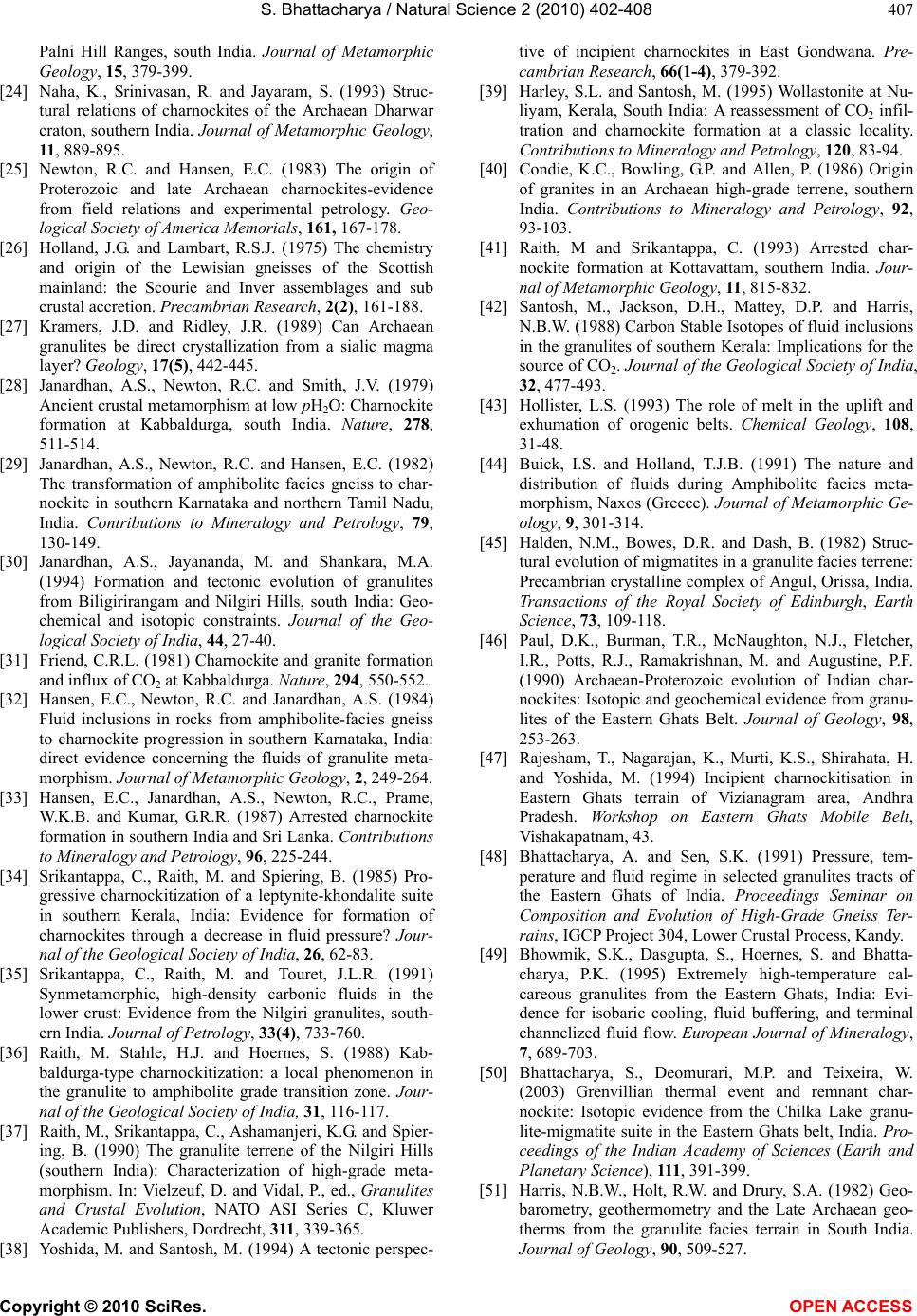 S. Bhattacharya / Natural Science 2 (2010) 402-408 Copyright © 2010 SciRes. OPEN ACCESS 407 Palni Hill Ranges, south India. Journal of Metamorphic Geology, 15, 379-399. [24] Naha, K., Srinivasan, R. and Jayaram, S. (1993) Struc- tural relations of charnockites of the Archaean Dharwar craton, southern India. Journal of Metamorphic Geology, 11, 889-895. [25] Newton, R.C. and Hansen, E.C. (1983) The origin of Proterozoic and late Archaean charnockites-evidence from field relations and experimental petrology. Geo- logical Society of America Memorials, 161, 167-178. [26] Holland, J.G. and Lambart, R.S.J. (1975) The chemistry and origin of the Lewisian gneisses of the Scottish mainland: the Scourie and Inver assemblages and sub crustal accretion. Precambrian Research, 2(2), 161-188. [27] Kramers, J.D. and Ridley, J.R. (1989) Can Archaean granulites be direct crystallization from a sialic magma layer? Geology, 17(5), 442-445. [28] Janardhan, A.S., Newton, R.C. and Smith, J.V. (1979) Ancient crustal metamorphism at low pH2O: Charnockite formation at Kabbaldurga, south India. Nature, 278, 511-514. [29] Janardhan, A.S., Newton, R.C. and Hansen, E.C. (1982) The transformation of amphibolite facies gneiss to char- nockite in southern Karnataka and northern Tamil Nadu, India. Contributions to Mineralogy and Petrology, 79, 130-149. [30] Janardhan, A.S., Jayananda, M. and Shankara, M.A. (1994) Formation and tectonic evolution of granulites from Biligirirangam and Nilgiri Hills, south India: Geo- chemical and isotopic constraints. Journal of the Geo- logical Society of India, 44, 27-40. [31] Friend, C.R.L. (1981) Charnockite and granite formation and influx of CO2 at Kabbaldurga. Nature, 294, 550-552. [32] Hansen, E.C., Newton, R.C. and Janardhan, A.S. (1984) Fluid inclusions in rocks from amphibolite-facies gneiss to charnockite progression in southern Karnataka, India: direct evidence concerning the fluids of granulite meta- morphism. Journal of Metamorphic Geology, 2, 249-264. [33] Hansen, E.C., Janardhan, A.S., Newton, R.C., Prame, W.K.B. and Kumar, G.R.R. (1987) Arrested charnockite formation in southern India and Sri Lanka. Contributions to Mineralogy and Petrology, 96, 225-244. [34] Srikantappa, C., Raith, M. and Spiering, B. (1985) Pro- gressive charnockitization of a leptynite-khondalite suite in southern Kerala, India: Evidence for formation of charnockites through a decrease in fluid pressure? Jour- nal of the Geological Society of India, 26, 62-83. [35] Srikantappa, C., Raith, M. and Touret, J.L.R. (1991) Synmetamorphic, high-density carbonic fluids in the lower crust: Evidence from the Nilgiri granulites, south- ern India. Journal of Petrology, 33(4), 733-760. [36] Raith, M. Stahle, H.J. and Hoernes, S. (1988) Kab- baldurga-type charnockitization: a local phenomenon in the granulite to amphibolite grade transition zone. Jour- nal of the Geological Society of India, 31, 116-117. [37] Raith, M., Srikantappa, C., Ashamanjeri, K.G. and Spier- ing, B. (1990) The granulite terrene of the Nilgiri Hills (southern India): Characterization of high-grade meta- morphism. In: Vielzeuf, D. and Vidal, P., ed., Granulites and Crustal Evolution, NATO ASI Series C, Kluwer Academic Publishers, Dordrecht, 311, 339-365. [38] Yoshida, M. and Santosh, M. (1994) A tectonic perspec- tive of incipient charnockites in East Gondwana. Pre- cambrian Research, 66(1-4), 379-392. [39] Harley, S.L. and Santosh, M. (1995) Wollastonite at Nu- liyam, Kerala, South India: A reassessment of CO2 infil- tration and charnockite formation at a classic locality. Contributions to Mineralogy and Petrology, 120, 83-94. [40] Condie, K.C., Bowling, G.P. and Allen, P. (1986) Origin of granites in an Archaean high-grade terrene, southern India. Contributions to Mineralogy and Petrology, 92, 93-103. [41] Raith, M and Srikantappa, C. (1993) Arrested char- nockite formation at Kottavattam, southern India. Jour- nal of Metamorphic Geology, 11, 815-832. [42] Santosh, M., Jackson, D.H., Mattey, D.P. and Harris, N.B.W. (1988) Carbon Stable Isotopes of fluid inclusions in the granulites of southern Kerala: Implications for the source of CO2. Journal of the Geological Society of India, 32, 477-493. [43] Hollister, L.S. (1993) The role of melt in the uplift and exhumation of orogenic belts. Chemical Geology, 108, 31-48. [44] Buick, I.S. and Holland, T.J.B. (1991) The nature and distribution of fluids during Amphibolite facies meta- morphism, Naxos (Greece). Journal of Metamorphic Ge- ology, 9, 301-314. [45] Halden, N.M., Bowes, D.R. and Dash, B. (1982) Struc- tural evolution of migmatites in a granulite facies terrene: Precambrian crystalline complex of Angul, Orissa, India. Transactions of the Royal Society of Edinburgh, Earth Science, 73, 109-118. [46] Paul, D.K., Burman, T.R., McNaughton, N.J., Fletcher, I.R., Potts, R.J., Ramakrishnan, M. and Augustine, P.F. (1990) Archaean-Proterozoic evolution of Indian char- nockites: Isotopic and geochemical evidence from granu- lites of the Eastern Ghats Belt. Journal of Geology, 98, 253-263. [47] Rajesham, T., Nagarajan, K., Murti, K.S., Shirahata, H. and Yoshida, M. (1994) Incipient charnockitisation in Eastern Ghats terrain of Vizianagram area, Andhra Pradesh. Workshop on Eastern Ghats Mobile Belt, Vishakapatnam, 43. [48] Bhattacharya, A. and Sen, S.K. (1991) Pressure, tem- perature and fluid regime in selected granulites tracts of the Eastern Ghats of India. Proceedings Seminar on Composition and Evolution of High-Grade Gneiss Ter- rains, IGCP Project 304, Lower Crustal Process, Kandy. [49] Bhowmik, S.K., Dasgupta, S., Hoernes, S. and Bhatta- charya, P.K. (1995) Extremely high-temperature cal- careous granulites from the Eastern Ghats, India: Evi- dence for isobaric cooling, fluid buffering, and terminal channelized fluid flow. European Journal of Mineralogy, 7, 689-703. [50] Bhattacharya, S., Deomurari, M.P. and Teixeira, W. (2003) Grenvillian thermal event and remnant char- nockite: Isotopic evidence from the Chilka Lake granu- lite-migmatite suite in the Eastern Ghats belt, India. Pro- ceedings of the Indian Academy of Sciences (Earth and Planetary Science), 111 , 391-399. [51] Harris, N.B.W., Holt, R.W. and Drury, S.A. (1982) Geo- barometry, geothermometry and the Late Archaean geo- therms from the granulite facies terrain in South India. Journal of Geology, 90, 509-527. 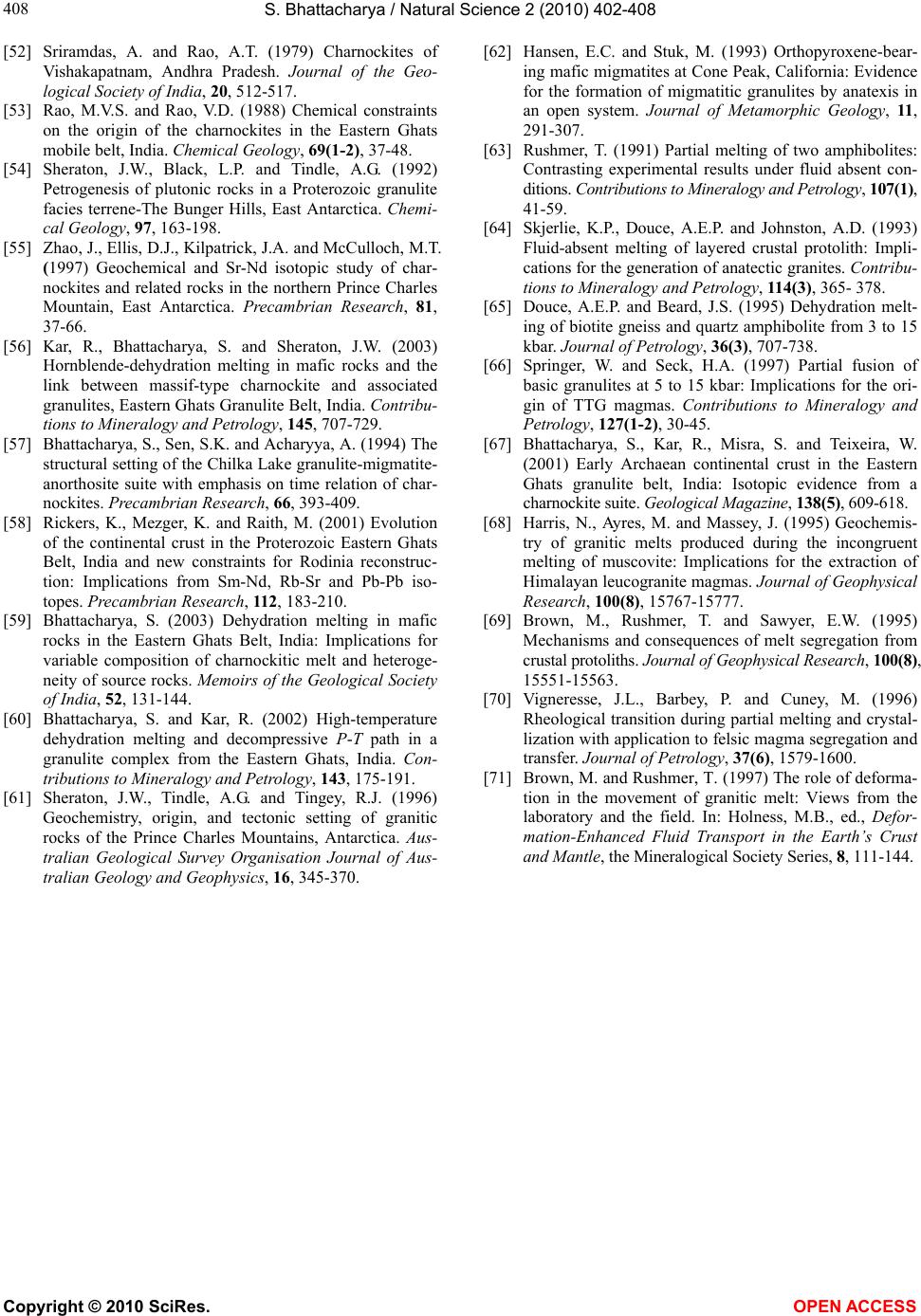 S. Bhattacharya / Natural Science 2 (2010) 402-408 Copyright © 2010 SciRes. OPEN ACCESS 408 [52] Sriramdas, A. and Rao, A.T. (1979) Charnockites of Vishakapatnam, Andhra Pradesh. Journal of the Geo- logical Society of India, 20, 512-517. [53] Rao, M.V.S. and Rao, V.D. (1988) Chemical constraints on the origin of the charnockites in the Eastern Ghats mobile belt, India. Chemical Geology, 69(1-2), 37-48. [54] Sheraton, J.W., Black, L.P. and Tindle, A.G. (1992) Petrogenesis of plutonic rocks in a Proterozoic granulite facies terrene-The Bunger Hills, East Antarctica. Chemi- cal Geology, 97, 163-198. [55] Zhao, J., Ellis, D.J., Kilpatrick, J.A. and McCulloch, M.T. (1997) Geochemical and Sr-Nd isotopic study of char- nockites and related rocks in the northern Prince Charles Mountain, East Antarctica. Precambrian Research, 81, 37-66. [56] Kar, R., Bhattacharya, S. and Sheraton, J.W. (2003) Hornblende-dehydration melting in mafic rocks and the link between massif-type charnockite and associated granulites, Eastern Ghats Granulite Belt, India. Contribu- tions to Mineralogy and Petrology, 145, 707-729. [57] Bhattacharya, S., Sen, S.K. and Acharyya, A. (1994) The structural setting of the Chilka Lake granulite-migmatite- anorthosite suite with emphasis on time relation of char- nockites. Precambrian Research, 66, 393-409. [58] Rickers, K., Mezger, K. and Raith, M. (2001) Evolution of the continental crust in the Proterozoic Eastern Ghats Belt, India and new constraints for Rodinia reconstruc- tion: Implications from Sm-Nd, Rb-Sr and Pb-Pb iso- topes. Precambrian Research, 112, 183-210. [59] Bhattacharya, S. (2003) Dehydration melting in mafic rocks in the Eastern Ghats Belt, India: Implications for variable composition of charnockitic melt and heteroge- neity of source rocks. Memoirs of the Geological Society of India, 52, 131-144. [60] Bhattacharya, S. and Kar, R. (2002) High-temperature dehydration melting and decompressive P-T path in a granulite complex from the Eastern Ghats, India. Con- tributions to Mineralogy and Petrology, 143, 175-191. [61] Sheraton, J.W., Tindle, A.G. and Tingey, R.J. (1996) Geochemistry, origin, and tectonic setting of granitic rocks of the Prince Charles Mountains, Antarctica. Aus- tralian Geological Survey Organisation Journal of Aus- tralian Geology and Geophysics, 16, 345-370. [62] Hansen, E.C. and Stuk, M. (1993) Orthopyroxene-bear- ing mafic migmatites at Cone Peak, California: Evidence for the formation of migmatitic granulites by anatexis in an open system. Journal of Metamorphic Geology, 11, 291-307. [63] Rushmer, T. (1991) Partial melting of two amphibolites: Contrasting experimental results under fluid absent con- ditions. Contributions to Mineralogy and Petrology, 107(1), 41-59. [64] Skjerlie, K.P., Douce, A.E.P. and Johnston, A.D. (1993) Fluid-absent melting of layered crustal protolith: Impli- cations for the generation of anatectic granites. Contribu- tions to Mineralogy and Petrology, 114(3), 365- 378. [65] Douce, A.E.P. and Beard, J.S. (1995) Dehydration melt- ing of biotite gneiss and quartz amphibolite from 3 to 15 kbar. Journal of Petrology, 36(3), 707-738. [66] Springer, W. and Seck, H.A. (1997) Partial fusion of basic granulites at 5 to 15 kbar: Implications for the ori- gin of TTG magmas. Contributions to Mineralogy and Petrology, 127(1-2), 30-45. [67] Bhattacharya, S., Kar, R., Misra, S. and Teixeira, W. (2001) Early Archaean continental crust in the Eastern Ghats granulite belt, India: Isotopic evidence from a charnockite suite. Geological Magazine, 138(5), 609-618. [68] Harris, N., Ayres, M. and Massey, J. (1995) Geochemis- try of granitic melts produced during the incongruent melting of muscovite: Implications for the extraction of Himalayan leucogranite magmas. Journal of Geophysical Research, 100(8), 15767-15777. [69] Brown, M., Rushmer, T. and Sawyer, E.W. (1995) Mechanisms and consequences of melt segregation from crustal protoliths. Journal of Geophysical Research, 100(8), 15551-15563. [70] Vigneresse, J.L., Barbey, P. and Cuney, M. (1996) Rheological transition during partial melting and crystal- lization with application to felsic magma segregation and transfer. Journal of Petrology, 37(6), 1579-1600. [71] Brown, M. and Rushmer, T. (1997) The role of deforma- tion in the movement of granitic melt: Views from the laboratory and the field. In: Holness, M.B., ed., Defor- mation-Enhanced Fluid Transport in the Earth’s Crust and Mantle, the Mineralogical Society Series, 8, 111-144. |

